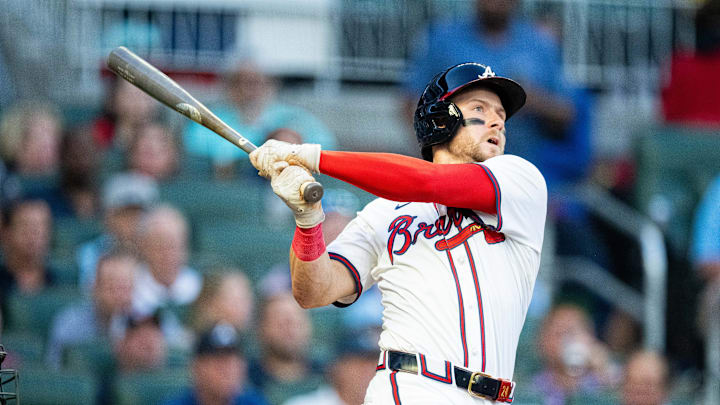Jarred Kelenic hit his first home run of the season with the Atlanta Braves this week. It ended a homerless streak dating back to June 9 when, of all people, he went yard against Shohei Ohtani. Once a first-round draft pick of the New York Mets who turned into one of those prospects dealt away in a crushing trade, the niche he has created for himself this year in Atlanta is far less satisfying than what many Mets fans would’ve accepted.
The 24-year-old has only 1 plate appearance all year against a left-handed pitcher. Platooning with veteran Adam Duvall has allowed Atlanta to keep him away from getting battered by southpaws. A career .188/.254/.310 hitter against lefties with 89 strikeouts in 295 trips to the plate, Kelenic has found himself putting up much better overall numbers when he plays less and only has to go against righties.
His problems in Seattle were much deeper than platoon splits. After all, a career .220/.301/.398 slash line against righties isn’t exactly what Mets fans thought he’d put together by now. The difference is Kelenic only has to worry about righties. A .290/.342/.382 hitter against them this year, he is on the war path to becoming a very good platoon player. In which case, we’re not so solemn about trading him away any longer.
Former Mets first round pick Jarred Kelenic has a role but still has things to work on
Despite a lack of exposure to left-handed pitchers, Kelenic still strikes out a ton. He’s at 32.5% this year which is about 10% higher than the league. Without much power to speak of this season or even last year for that matter, a lot of what Kelenic is doing looks like the Dominic Smith tenure in New York.
Smith, also a much-hyped prospect, wound up with several years hitting below .200 in New York only to find himself in a part-time role as a left fielder and occasional first baseman. The two situations aren’t exactly the same but the correlation is there. Smith never found his home run stroke on a consistent basis either. He never was much of a power hitter in the minor leagues. Kelenic, on the other hand, was hitting dingers. In fact, he had 23 in the minors a year after the Mets traded him to the Seattle Mariners.
The absence of power for a corner outfielder isn’t the greatest chapter in a young career. Kelenic has played a solid left field for the Braves this year. And on a roster where they have several guys capable of hitting 30 home runs or more, it was a more than acceptable project to take on this offseason.
Kelenic’s yet to be determined future will be one we’ll all watch regardless of whether we want to or not. His presence on the Braves means we have to pay attention to him a little more closely, at least right now. As far as the intrigue of major league players goes, he’s a case regardless of his history with the Mets that’s a bit curious. His similarity score on Baseball-Reference currently has him matched with Billy McKinney. A Mets outfielder for a short period in 2021, he became a journeyman rather quickly due to a lack of minor league options. Typically a low average hitter without a whole lot of power but some, this is the floor of what Kelenic can become.
The ceiling? He’ll need to do more than hit singles against righties to stay as a starter. He’s not the next Tony Gwynn. The .286 batting average has surely been a delight for Braves fans and yet the career at .211 stands out as a warning.
Early success for Kelenic in 2024 should have him remaining a regular option for the Braves and maybe other teams in the future. It’s a matter of whether he solves those limitations or because the left field version of Daniel Vogelbach.
